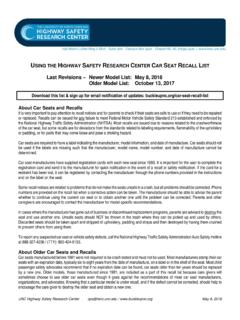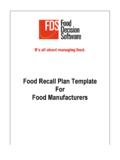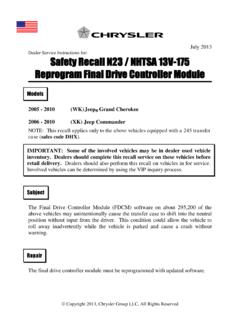Transcription of Food Product Recalls Guidance for Industry
1 Food Product Recalls Guidance For Industry Food and Dairy Division Box 30017. Lansing, MI 48909. February 2008 517-373-1060. Table of Contents Introduction .. 1. Abbreviations .. 1. recall Terminology .. 2. recall Classifications .. 3. Public Notification and the Press Release .. 5. Example Press Releases .. 6. Recommended Wording for Specific Contaminants .. 9. Example Customer Notification Letter ..10. Example of In-Store Notification .. 11. Regulators' Roles and Authority .. 11. Contacts and Additional Resources ..12. Introduction A food recall is a firm's voluntary removal of distributed food products from commerce when there is a reason to believe that such products are adulterated or misbranded under the provisions of applicable state and federal laws.
2 All food firms should have a recall plan in place, in order to act promptly and effectively in the event of a recall . Being prepared reduces the risk of potentially harmful or hazardous food from reaching consumers and potentially wreaking devastating effects on human health and the economy. This document is not intended to be an all-inclusive recall guide, however, the Michigan Department of Agriculture is providing helpful information that Industry can incorporate into their food recall plans. Abbreviations FDA: Food and Drug Administration MDA: Michigan Department of Agriculture USDA: United States Department of Agriculture HACCP: Hazard Analysis and Critical Control Points CFSAN: Center for Food Safety and Applied Nutrition (one of six centers within the FDA).
3 1. recall Terminology recall A firm's voluntary removal of distributed food products from commerce when there is reason to believe that such products are adulterated or misbranded under the provisions of applicable state and federal laws. recall does not include a market withdrawal or a stock recovery. Market Withdrawal A firm's removal or correction by its own volition of a distributed Product that involves a minor infraction that would not warrant legal action by MDA, or involves no violation of the state or federal laws, or health hazard. Stock Recovery A firm's removal or correction of Product that has not been marketed or has not left the direct control of the firm. For example, Product is located on premises owned by or under the control of the firm and no portion of the lot has been released for sale or use.
4 recall Classifications MDA assesses the public health concern or hazard presented by a Product being recalled, or considered for recall , whether firm-initiated or requested by MDA, and classifies the concern using criteria developed by the FDA: Class I A situation in which there is a strong likelihood that the use of, or exposure to, a violative Product will cause serious adverse health consequences or death. Class II A situation in which use of, or exposure to, a violative Product may cause temporary or medically reversible adverse health consequences or where the probability of serious adverse health consequences is remote. Class III A situation in which use of, or exposure to, a violative Product is not likely to cause adverse health consequences.
5 Depth of recall The level of Product distribution to which the recall is to extend: Consumer level This includes household consumers as well as all other levels of distribution. Retail level This includes all retail sales of the recalled Product . User level This includes hotels, restaurants, and other food service institutional consignees. Wholesale level This is the distribution level between the manufacturer and the retailer. This level may not be encountered in every recall situation ( , the recalling firm may sell directly to the retail or consumer level). Scope This defines the amount and kind of Product in question. For example, all products produced under a single HACCP plan between performance of complete cleaning and sanitation procedures (clean up to clean up).
6 Disposition The firm's action to correct a situation leading to the recall such as relabeling, reworking, or destroying Product . 2. recall Classifications Examples of Class I, II, and III recall Situations recall classifications often occur on a case-by-case basis. Certain hazards may be classified as Class I, II, or III depending on circumstances and risk. Each unique situation cannot be captured in list format, therefore the following list is meant as a guide only. When the state is assisting with a recall , the FDA or the USDA is consulted as appropriate to assure proper recall classification. Note: Currently, CFSAN has not officially classified many allergens. Allergens below are put into categories of most common classification based on recall postings.
7 Class I. A situation in which there is a strong likelihood that the use of, or exposure to, a violative Product will cause serious adverse health consequences or death. Examples Listeria monocytogenes in ready-to-eat food Clostridium botulinum toxin E. coli O157:H7. Salmonella sp. in ready-to-eat food Uneviscerated fish (Kapchunka) greater than 5 in length (FDA Compliance Policy Guide ). Excessive/undeclared sulfites Note: May be Class I, II, or III depending on level of sulfites present in the Product . An algorithm is available to help make this determination. Undeclared Crustaceans such as: - Shrimp - Crab - Crayfish - Lobster Undeclared peanuts, includes ingredients such as : - Peanut butter - Peanut flour Note: Hydrolyzed peanut protein and peanut oil may or may not present a hazard to an allergic individual, depending on how they were processed.
8 Undeclared tree nuts - Hazelnuts or filberts - Walnuts - Pecans - Cashews - Brazil nuts - Almonds - Pistachios - Chestnuts - Macadamia nuts - Hickory nuts - Pine nuts Undeclared eggs - Egg white - Egg yolk - Ingredients such as egg albumen and powdered eggs 3. Undeclared dairy- includes any ingredient which contains protein from milk such as: - Milk - Cream - Dry milk - Whey Undeclared soy - Soybeans - Soy protein - Soy flour Note: Generally, soy oil, soy lecithin and hydrolyzed soy protein are not included, since these may be processed in a manner that eliminates or denatures the protein. Undeclared fish Class II. A situation in which use of, or exposure to, a violative Product may cause temporary or medically reversible adverse health consequences or where the probability of serious adverse health consequences is remote ( , yellow #5, filth).
9 Examples Certain coloring agents- See 31 CFR (k) (3) for requirements specific to color declaration on butter, cheese and ice cream. Norovirus Excessive/undeclared sulfites Note: May be Class I, II, or III depending on level of sulfites present in the Product . An algorithm is available to help make this determination. Certain unapproved additives or ingredients Note: Refer to the Federal Food, Drug and Cosmetic Act as amended for specific circumstances. Generally considered as Class II are foods which contain the following: pesticide residues within the meaning of section 408 (a), food additives unsafe within the meaning of section 409, new animal drugs unsafe within the meaning of section 512, and color additives unsafe within the meaning of section 721 (a).
10 Undeclared wheat Class III. A situation in which use of or exposure to a violative Product is not likely to cause adverse health consequences ( , technically misbranded). Examples Undeclared certified colors. Refer to CFSAN and FDA Federal Food, Drug and Cosmetic Act, section 721 (a). Decomposition Filth Mold contamination (may depend on type of mold involved). Excessive/undeclared sulfites Note: May be Class I, II, or III depending on level of sulfites present in the Product . An algorithm is available to help make this determination. Minor labeling problems ( , format, undeclared ingredients that are not allergens). 4. Public Notification and the Press Release Public notification is important, particularly in situations where the recalled Product may pose a significant health hazard and may be in the hands of consumers.















